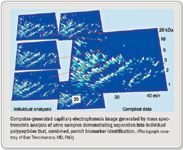Article
Biomarker test aids diagnosis of urothelial cancer
Charlottesville, VA-Using sophisticated technology forbiomarker identification, researchers at the University ofVirginia, in collaboration with industry partners, have developed adiagnostic test that offers high specificity for discriminatingbladder cancer from a variety of non-cancerous urologic conditionsthat are common mimics of bladder cancer.

The research is reported in a recently published article in Lancet Oncology (2006; 7:230-40).
The methodology involved application of bioinformatics tools and capillary-electrophoresis-couple mass spectrometry to characterize polypeptide patterns in urine samples from groups of patients with urothelial carcinoma, healthy volunteers, and patients with other benign and malignant genitourinary conditions. Those analyses identified a diagnostic pattern for urothelial carcinoma based on 22 polypeptide masses, along with two other patterns of polypeptides of 11 masses each for non-malignant genitourinary disease and non-urothelial genitourinary cancer.

The results showed the urothelial-carcinoma diagnostic panel had 100% sensitivity and specificity in correctly identifying all samples from patients with urothelial carcinoma and differentiating them from healthy individual specimens. Discrimination of patients with urothelial carcinoma from those with other malignant or benign genitourinary diseases ranged from 86% to 100% when all three diagnostic patterns were applied.
"Currently, it is challenging for noninvasive diagnostic tests to accurately differentiate bladder cancer from the many non-malignant genitourinary conditions that are mimics of bladder cancer," said Dan Theodorescu, MD, PhD, Paul Mellon Professor of Urologic Oncology and Molecular Physiology, and director of the Paul Mellon Pros-tate Cancer Institute, University of Virginia Health System, Charlottesville. "The high specificity of the test we have created makes it an excellent platform for developing a future diagnostic test that can be applied in the clinical setting."
The 22 biomarkers for urothelial cancer were first identified using urine samples from a "training set" of subjects consisting of 46 patients with urothelial carcinoma who had undergone cystectomy and 33 healthy volunteers who had no suspicion or history of urothelial carcinoma. In that series, the urothelial-cancer diagnostic pattern had a specificity of 100% and sensitivity of 98%, as it incorrectly classified one urothelial-cancer sample.
Further refinement of the model was undertaken using spontaneously voided urine samples from a series of 366 subjects that included additional patients with urothelial cancer and healthy individuals, as well as persons with other genitourinary malignancies or non-malignant genitourinary diseases. Analyses in that group led to determination of the biomarker patterns associated with non-malignant genitourinary diseases and non-urothelial cancers.
Eliminating confounding factors
In blinded validation testing using samples from that series of subjects, use of the urothelial-carcinoma pattern by itself to classify samples from patients with other benign and malignant genitourinary diseases resulted in a high number of false positives. Misclassification rates were highest for patients with vasculitis (42%) and post-renal transplantation (44%), and were lowest for prostate cancer (5%) and renal cancer (4%).
When the analyses included the non-malignant disease and the urothelial-cancer patterns, the false-positive classification rate for patients with renal disease and inflammatory disease fell to 3%. The diagnostic test had 100% specificity in identifying non-urothelial cancers when all three biomarker patterns were applied.
"These results illustrate the utility and need for multiple biomarkers to account for the many confounding conditions that can complicate the diagnosis of urinary disorders, including cancer," Dr. Theodorescu said.















